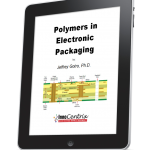In our series on polymers in electronics late last year, materials for fan-out wafer level packaging were covered in some detail. I attended the Electronic Components and Technology Conference (ECTC) the last week in May and in the next several posts, I will highlight what I see as some of the emerging themes. With fan-out wafer level packaging (or whatever name the various ... [Click to Continue...]
Electron Microscopy and the Polymer Guy
The expanded and updated eBook "Rheology of Thermosets" is completed and available on the site. Check it out here The updated "Dielectric Cure Monitoring" ebook will be released shortly followed by the "Polymers in Electronic Packaging" ebook. I was attending the Electronic Components and Technology Conference (ECTC) last week. The ECTC is the largest conference ... [Click to Continue...]
Happy Memorial Day
Have a safe and relaxing Memorial Day ... [Click to Continue...]
New and Updated eBooks Coming Soon
I am in the process of updating some of my popular eBooks and will add a new eBook to my line-up very shortly. Updated eBooks: Rheology of Thermosets is being expanded with significant additions to the content. The following figure shows the organization of the ebook. The updated eBook will cover rheological ... [Click to Continue...]
Dielectric Cure Monitoring Part Seven: Real-Time Monitoring of UV Cure
Guest Post by Huan Lee, Lambient Technologies I’d like to conclude this series by highlighting the unique ability of dielectric cure monitoring (DEA) to measure cure in real-time, which is valuable for studying materials that polymerize in seconds. In this last post I test Quad-CureTM 1933, a glass-metal bonder manufactured by Incure, Inc. [Ref. 1]. Quad-CureTM 1933 is a ... [Click to Continue...]



